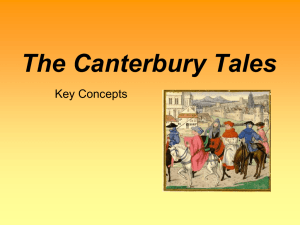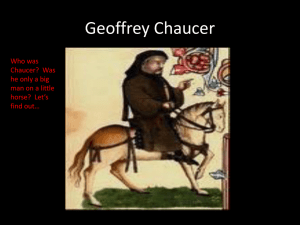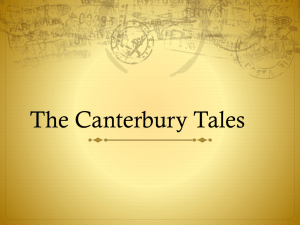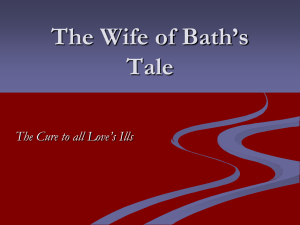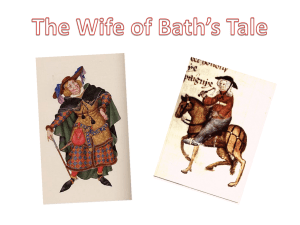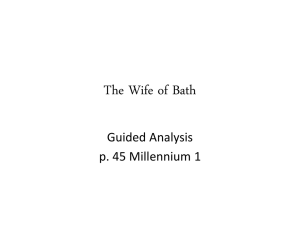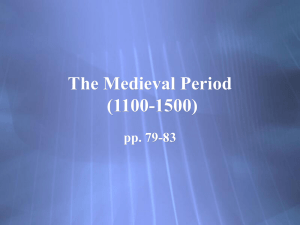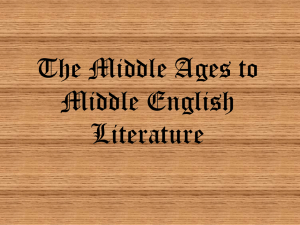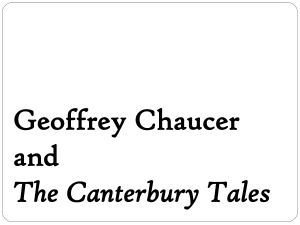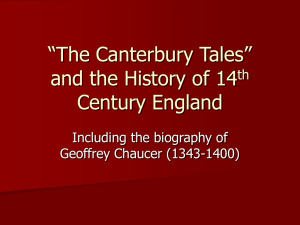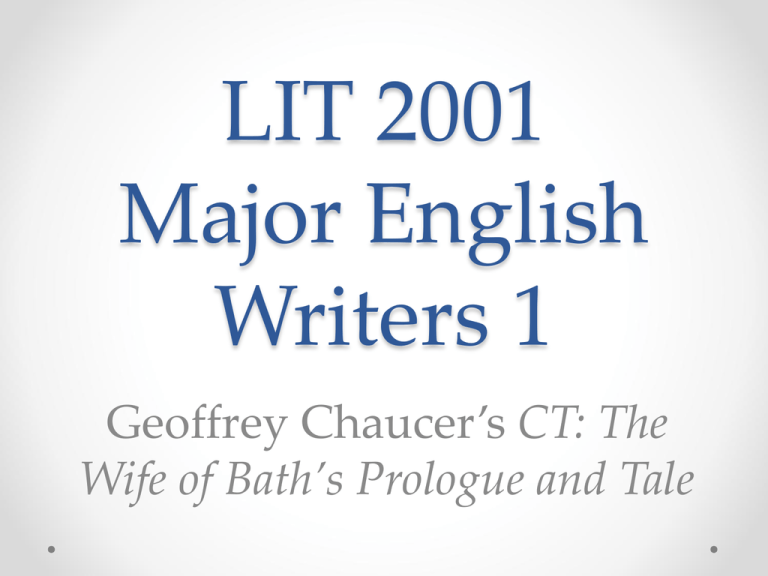
LIT 2001
Major English
Writers 1
Geoffrey Chaucer’s CT: The
Wife of Bath’s Prologue and Tale
Geoffrey Chaucer’s CT:
The Wife of Bath’s Prologue and Tale
Historical / Cultural Background: Treatment of Married
Women and Attitudes toward Sex in the Middle Ages.
• In the Middle Ages, women were portrayed in a
terrible light.
• Many laws existed concerning sexual relations
between married people.
• How do you prevent men (in this male-dominated
society) from sinning in sexual matters? Portray
women as terrible creatures.
• This is the kind of society the Wife of Bath would
have lived in.
Geoffrey Chaucer’s CT:
The Wife of Bath’s Prologue and Tale
The Wife of Bath's Prologue: Genres
• a dramatic monologue
• a confession
• a secular sermon
• sermon + exemplum = prologue + tale
Geoffrey Chaucer’s CT:
The Wife of Bath’s Prologue and Tale
Three-Part Division of The Wife of Bath's Prologue
• Dame Alice's justification of her attitudes toward sex
and marriage (Lines 1-198)
• Dame Alice's first three marriages (Lines 199-458)
• Dame Alice's fourth and fifth marriage (Lines 459-834)
Geoffrey Chaucer’s CT:
The Wife of Bath’s Prologue and Tale
Dame Alice's justification of her attitudes
toward sex and marriage (Lines 1-198)
•
•
•
•
Lines 26-50
Lines 65-78
Lines 111-134
Lines 145-156
Geoffrey Chaucer’s CT:
The Wife of Bath’s Prologue and Tale
Dame Alice's first three marriages (Lines 199-458)
• Lines 199-222: The first three husbands were "goode,
and riche, and olde" (203)
• Lines 225-29: Alice likes her first three husbands
because they were easy to dominate and control
• Alice got what she wanted from her husbands:
money, possessions, love (though she didn't seem to
love them), sexual satisfaction.
Geoffrey Chaucer’s CT:
The Wife of Bath’s Prologue and Tale
Dame Alice's Fourth and Fifth Marriage (Lines 459-834)
• Note digression showing Alice's more tender side (Lines
475-85)
• Dame Alice's answer to control of her forth husband: "[I]n
his owene grece I made him frye" (Line 493)
• The fifth husband, Janekin, is the only husband Alice
married for love, not for money (lines 531 ff.)
• Dame Alice struggles to gain dominance over Janekin
• Lines 698-702: “Who painted the leon, tell me who?”
• Lines 794-843: Alice finally gains control
Geoffrey Chaucer’s CT:
The Wife of Bath’s Prologue and Tale
The Wife of Bath’s Tale
• What similarities are there between Dame Alice and
the tale she tells? (How is her tale an especially
appropriate one for her to tell?)
• From the textbook introduction: “As Chaucer has the
Wife tell it, the tale expresses her views about the
relation of the sexes, her wit and humor, and her
fantasies.”
Geoffrey Chaucer’s CT:
The Wife of Bath’s Prologue and Tale
The Wife of Bath’s Tale
• Lines 888-904: The Knight’s crime
• Lines 931-934: What do woman most desire?
• The old woman tells the knight that what women
most desire is control over their husbands; the
knight’s life is saved, but the old woman asks for him
to marry her.
• Lines 1064-1067, 1106-1111: The knight’s reaction to
being asked to wed the old woman
Geoffrey Chaucer’s CT:
The Wife of Bath’s Prologue and Tale
The Wife of Bath’s Tale
• Lines 1115-1124, 1156-1170: The woman explaining
“gentilesse”
• One dictionary definition of “gentilesse” (archaic):
“Refinement and courtesy resulting from good
breeding”
• Lines 1225-1264: The knight’s choice and his decision
• Lines 1264-1270: The Wife’s final comments
Geoffrey Chaucer’s CT:
The Wife of Bath’s Prologue and Tale
The Wife of Bath’s Tale
• What is the “lesson” or “lessons” about love and
marriage presented in The Canterbury Tales: The Wife of
Bath’s Tale?
• What similarities are there between Dame Alice and
the tale she tells? (How is her tale an especially
appropriate one for her to tell?)

